Monday, November 30, 2009
SIDELINE: MORE REVIEWS FOR 11/09
IN THEATRES...
* An Education, the Nick Hornby-penned coming-of-age tale makes a real star out of Carey Mulligan. One of my favorite movies of the season.
* Fantastic Mr. Fox, the awesome realization of Wes Anderson's childhood.
* The Men Who Stare at Goats has a great cast--George Clooney, Jeff Bridges, Ewan McGregor, Kevin Spacey--but doesn't have a complete script to match.
* Precious: Based on the Novel 'Push' by Sapphire, a melodrama that gets by on the strength of its acting, but the script's contrivances aren't quite up to the hype. I actually really liked Alison Hallett's review at the Mercury. You should read it.
* The Road, John Hillcoat's adaptation of Cormac McCarthy.
ON DVD...
* The Barbara Stanwyck Show, vol. 1, an unearthed television show starring the great actress. A little disappointing, but worth a look.
* The Dead, John Huston's final film finally comes to DVD, so why did Lionsgate screw it up so bad? Ten minutes missing? Did you leave it in your horse and buggy? Thankfully, I got an e-mail from Lionsgate and they are issuing replacements. I've added info to my review in case anyone needs to do a trade-in. Very good news!
* Funny People, the Judd Apatow drama was lost this summer, but proves an excellent DVD.
* Gilda Live!, Gilda Radner's live show from 1980.
* Johnny Mercer "The Dream's On Me", a documentary celebrating the 100th anniversary of the famous songwriter's birth.
* Lemon Tree, an effective Israeli drama about one woman's fight to protect her heritage.
* The Limits of Control, Jim Jarmusch's latest, a challenging and misunderstood journey through the artistic process.
* Toi & Moi, a romantic comedy starring Marion Cotillard that fails to generate any heat.
Labels:
huston,
jarmusch,
other reviews,
wes anderson
Thursday, November 26, 2009
THE GOLDEN AGE OF TELEVISION - #495

Years ago, I was co-host of a cable access show. Every two weeks, we'd be live on Portland television for an hour, showing music videos, working without a script. Hardly anybody watched it, there were no consequences if we sucked, but even so, that hour was a nerve-wracking, electrified, exciting time. We were beaming across the city to whatever homes had cable, to whoever might have happened across us while scanning the airwaves with their remote controls. What a thrill! From the signal that we were on the air to the studio's screen going black, whatever happened happened, there was no taking it back.
I can only imagine what it must have been like to do live television dramas in the 1950s. The best I can do is try to marry my slim community theatre experience with the cable access experience. Put together a scripted show where I had to remember lines and hit my marks with that feeling of reaching beyond the protected performance space, that what we were doing wasn't just going to be seen by those in the immediate vicinity, but potentially by hundreds. Thousands. Millions. It wasn't just a matter of showing up and running out the clock, you'd really have to perform.
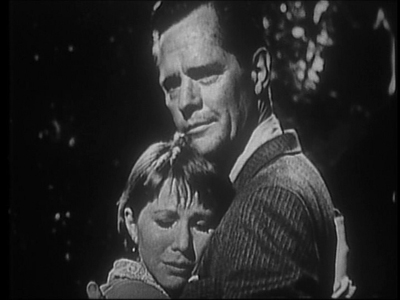
That's how TV was done in the early days. Live shows, like hour-long plays, often with the best and the brightest of Broadway, new talent cutting their teeth in a new media. Eight of these programs are collected in the new Criterion boxed set, The Golden Age of Television. The collection is named for a PBS series that showcased this exciting time. The original presentations were performed live on the East Coast, shot with multiple cameras, but in the days before video tape, so no clean way to capture what was happening. The filmmakers edited as they went, it wasn't on film. What PBS resurrected and what they showed when this series first ran back in the early 1980s, bringing these vintage teleplays back to the air for the first time in decades, were recordings called "kinescopes." Essentially, kinescope was a process of photographing the broadcast by pointing a special camera at a video monitor. Like if you took a camera yourself and set it up in front of your TV and recorded a show. It wasn't perfect--you can sometimes see the curve of the screen, or a speck of dirt on the glass, or any number of glitches--but it was the only way to prevent these programs from just disappearing into thin air.
The material here is the cream of the crop, chosen from hours of television. Amongst the shows, we get early scripts from writers as revered as Paddy Chayefsky, Ira Levin, and Rod Serling, direction from future legends like John Frankenheimer, and performances by Ed Begley, Andy Griffith, Rod Steiger, Elizabeth Montgomery, George Peppard, Paul Newman, Julie Harris, Kim Hunter, Jack Palance, Mel Torme, and Piper Laurie in roles both big and a small. There are also small-screen turns by established big-screen stars like Everett Sloane, Edmond O'Brien, and Mickey Rooney. Structured more like the legitimate theatre, these high-wire acts show a precision of craft and a dedication from the talent we don't see all that much anymore. There were no do-overs. They only got one shot.
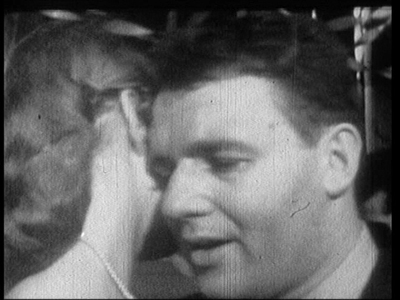
*** Disc 1 ***
Marty (1953): Directed by Delbert Mann and written by Paddy Chayefsky, this initial version of Marty predates the Oscar-winning movie
Marty eventually meets a woman, a schoolteacher (Nancy Marchand), at a dancehall. He becomes aware of her when another guy asks him to take her off his hands. They had come here on a blind date, and he's decided she's a dog. Seeing a familiar crack in her broken heart, Marty risks further pain by sharing his hurt with the girl, and they see glimmers of happiness in one another. It's a tender story, enacted with a touching sensitivity. Steiger is the epitome of a gentle giant, and his expressions of doubt and heartache are disarming coming not just from a man of his size, but any man really. It's not usually the fella we see waiting at home for the phone to ring in romantic stories. Chayefsky builds Marty's predicament with such care, layering the story with thematic parallels, that he staves off any impending mawkishness. Marty is sweet and touching, but it's not manipulative, it comes by those heartstrings it tugs honestly.
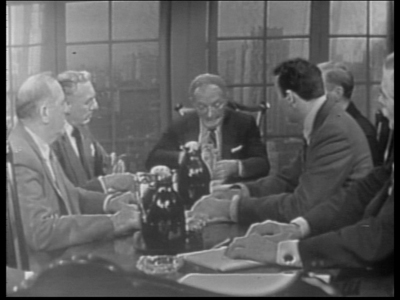
Patterns (1955): Rod Serling's big-business drama caused a sensation when it first aired, and it went a long way to building the reputation that would eventually lead to the writer landing his own series, The Twilight Zone
Rod Serling's strength has always been socially conscious dramas that manage to wear their pointed message out in the open, but like Chayefsky, he wrote in such a way that it never seemed obvious or cloying. In Patterns, the pieces all move with precision--there is the hard-charging boss, the rising star and the fading champ, the secretary who sees everything (Elizabeth Wilson), the wife (June Dayton) who wants to see her husband climb the ladder. Everyone has a function, but the way the gears lock together never show. Grandstanding speeches come off as natural. They are written with an ear for speech, and spoken by true masters. Ed Begley is fragile as the aging executive, losing the last grip he has on stability, and Everett Sloane is ruthless as the company president. It's all Richard Kiley can do to remain standing between them as they obliterate one another.

No Time for Sergeants (1955): The lone comedy in the set stars Andy Griffith as Will Stockdale, the country bumpkin draftee who gets through the army on his blind luck, blind charm, and well, blind everything. His is the kind of character who never seems to clue in to what all is going on around him, to the precariousness of his situation or the dismay he may be causing others. In truth, they are uptight and overly concerned with rules and such; he is free to be himself.
No Time for Sergeants was adapted by Ira Levin (Rosemary's Baby
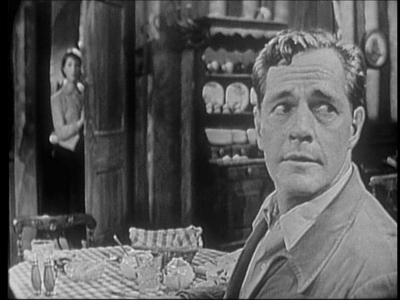
*** Disc 2 ***
A Wind from the South (1955): This quiet love story set in Ireland stars Julie Harris as Shevawn, the sisterly half of a brother/sister duo running a bread and breakfast in the countryside. Unlike her angry brother (Michael Higgins), Shevawn hasn't resigned herself to a life stuck in her hometown, she dreams of travel, a fantasy life fueled by the lives in transit passing through their establishment. Amongst the current guests is the American ad man Robert (Donald Woods), a man equally frustrated with his stagnant life, but who covers his frustrations with jocularity, poetry, and drink. Shevawn and Robert share a brief one-night affair, one that stirs both of them, and that plays out in surprising, satisfying ways. The emotional denouement shows a lot of depth. The script is by James Costigan, a notable name in early television, and inspired by, of all things, an album of songs recorded by Merv Griffin in tribute to The Quiet Man (Collector's Edition)
Harris was a Broadway star who would be one of the emerging talents in 1950s television; she would match this success with big screen triumph in A Member of the Wedding and East of Eden
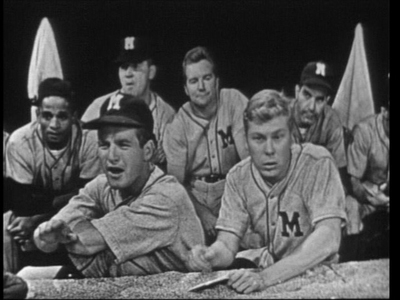
Bang the Drum Slowly (1956): Daniel Petrie also directed this baseball story, adapted by Arnold Schulman from a book by Mark Harris. A young Paul Newman stars as Henry "Author" Wiggen, the first-person narrator of the story. He is a minor league pitcher who becomes entangled in the life of his catcher, Bruce Pearson (Albert Salmi), a player of little talent and even less brains. When Bruce becomes terminally ill, Author takes him under his wing, doing his best to keep his ailment a secret so he doesn't get cut from the team. The locker room talk here is pretty tame, but the camaraderie is still a lot of fun. Author is an amusing character, hung up on taxes and caught up in his own story to a point where he almost forgets that it's someone else's tale he's telling.
Or maybe that's the consequence of having Paul Newman leading the charge. He's an electric performer, even at this stage, imbuing Author with an Actor's Studio twitchiness. The method gets in the way of Newman's naturalism a little, but his inherent charisma and comfort in front of the camera was too pronounced to squash. Albert Salmi is also very good. I am used to seeing him as the heavy, but he is quite convincing as a big palooka.
Speaking of big palookas...
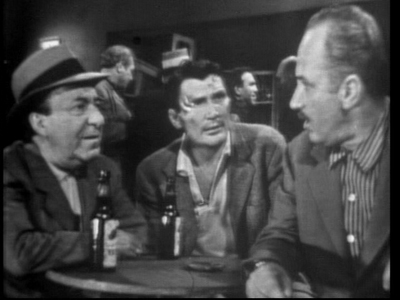
Requiem for a Heavyweight (1956): This famous Rod Serling drama was one of the first productions on "Playhouse 90," the series that ushered in the 90-minute drama. If these guys could do a full hour, why not an hour and a half? No big deal, right?
Well, it was a big deal, but Requiem makes it look easy. Jack Palance stars as Mountain, a boxer who is over-the-hill at 33. He lost his latest bout in a big way, and the doctor says if he keeps fighting, he'll go blind. To make matters worse, his trusted manager, Maish (Keenan Wynn), didn't think he could make it past three rounds, and when the bruiser manages to take it to seven, Maish doesn't make book and it puts the gambler in big-time hock. As Mountain tries to figure out what to do with himself if he's not fighting, Maish has to figure out how he's going to pay off the gangsters. In between is the cut-man Army (Ed Wynn), who'd like to see both of his friends get out of their predicaments with dignity.
Requiem for a Heavyweight is a remarkable piece of work. It set the standard for boxing stories, so much so that filmmakers are still borrowing from it to this day. Jack Palance is nearly unrecognizable as the punchy knuckleduster, turning his massive girth into sensitive mush. His relationship with Kim Hunter's employment officer is sweet and believable, the smart gal falling for the gentle giant. Serling's ability to capture the essential human decency of any situation makes Requiem more than your basic sports story, he takes this very specific tale of descent and makes it a play about universal triumph.
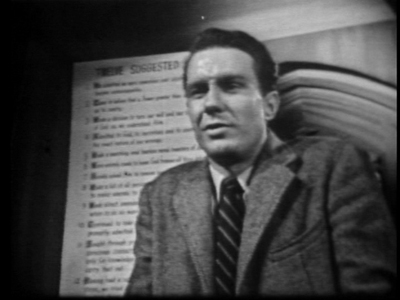
*** Disc 3 ***
The final disc belongs to John Frankenheimer, an innovative director who would move from television to direct movies like The Manchurian Candidate
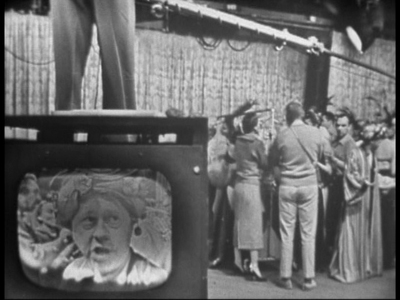
The Comedian (1957): The Comedian opens in a television studio, jumping back and forth between the control booth and the floor, staging close-ups using a video monitor in the extreme foreground, showing us the tail end of a disastrous rehearsal for comic legend Sammy Hogarth's latest extravaganza. Hogarth, played with knowing verve by Mickey Rooney, is making his transition into 90-minute television. How meta can you get? Based on a story by respected writer Ernest Lehman, this Rod Serling teleplay tears the live TV world apart, showing us the inflated egos of its stars and the people they destroy from the top on down. Edmond O'Brien (D.O.A.
The Comedian is unrelenting and sometimes brutal. Sammy is an irredeemable character, even with the hidden pain Serling unearths in the final act. He's not meant to be redeemed, we're only meant to see the source of his pathology. The actors are all incredible. Rooney is incendiary, O'Brien is tragic and feral, and the only nobility in the play belongs to the women, with Kim Hunter and Constance Ford seeing the writing on the wall long before their men do. Torme is the only weak link, his portrayal of Lester Hogarth never quite coming together, perhaps a case of the character's weakness overtaking the actor.
Frankenheimer is the real star, though. The Comedian is an ambitious piece of work, full of inventive, nearly surreal set pieces and featuring a final-act montage that must have been a real bear to undertake. Layering stock footage and scenes of the Sammy Hogarth show, he elevates this one-off production to a level that was equal to anything playing at the local movie house.
As an aside, The Comedian is introduced by Claudette Colbert, whom we learn over the closing credits is scheduled to be on "Playhouse 90" the following week. Likewise, Sterling Hayden introduces the next program...

Days of Wine and Roses (1958): This hard-hitting drama about alcoholism was probably the first time most Americans saw inside an Alcoholics Anonymous meeting. Cliff Robertson stars as Joe Clay, the anonymous witness for this session, who tells the story of his drinking life with Kirsten Arnesen (Piper Laurie). They met through booze and stayed together with booze, and the J.P. Miller script tracks the ups and downs of their relationship, the highs and the incredible lows. They fail more than once to kick the sauce, and Joe's AA membership acts as a wedge between them, redefining how they look at one another. The show looks at not just how drinking affects the pair, but their family and the people around them.
Like Requiem for a Heavyweight's boxing clichés, a lot of what we see here has become standard practice for addiction-based melodramas, and though the final scene featuring Joe reciting the serenity prayer may seem a little hokey now, I doubt it was as commonplace in 1958. Cliff Robertson and Piper Laurie really go through the ringer in Days of Wine and Roses, they must have felt like they were running a marathon. So demanding was the show, Frankenheimer actually elected to pre-record the scenes at AA, he couldn't have Cliff Robertson running back and forth and changing his suit as much as would be required. One scene these guys are sober, the next they are drunk--there are even a couple of detox sequences. Surprisingly, Miller doesn't wrap everything up neatly in the end, either. Not everyone walks away happy.

The thing about watching The Golden Age of Television is that you would never know these productions were recorded live if you weren't told. They aren't gimmicky or shambolic, they aren't simply one-room sets like filming a stage play within its confined space. What is still amazing to see is how deftly these filmmakers pulled this off, how seamlessly they move from one location to the next, from character to character, never letting the cracks show. These are fine-tuned productions, expertly rehearsed, carefully honed to come off without a hitch. These dramas were meant to compete with motion pictures--and they do. Quite easily.
The Golden Age of Television - Criterion Collection is an invaluable historical document that also manages to be a potent testament to the quality of early television drama (and one comedy!). These eight shows, recorded live between 1953 and 1958, show a medium in emergence, propelled by unmatched talent. The writing, direction, and acting--every aspect of the performance--is a wonder to behold, and all the more impressive for the fact that this was all done exactly as we see it here. No retakes, no do-overs, pure live theatre--though not the traditional trodden boards, the theatre of the air!
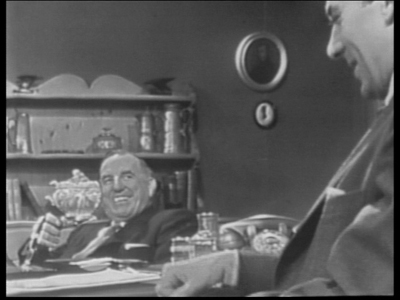
For a full rundown on the special features, read the full article at DVD Talk.
Friday, November 20, 2009
MAYERLING - ESSENTIAL ART HOUSE

Well, I guess it just goes to show, you're never as smart as you think. Here's what I knew about Mayerling: that it showed up regularly on lists of Audrey Hepburn movies as a 1957 television production the actress starred in opposite her then husband, Mel Ferrer. I had always hoped this show would one day surface, being pretty much the only significant television appearance Hepburn made in the first half of her career. I didn't know anything about the story, much less that it was based on a true event and that there were a bunch of other film versions of the tale. All were based on what is known as the "The Mayerling Incident," an 1889 scandal involving the murder-suicide of Crown Prince Rudolf of Austria and his lover, Baroness Maria Vetsera. Live and learn.
Anatole Litvak directed that Hepburn performance, twenty years after he helmed the story for the first time in this French production, realeased here as part of Criterion's Essential Art House line and which also happens to be the first dramatization of the affair. Made in 1936, Mayerling stars Charles Boyer as Rudolf and Danielle Darrieux as Maria. The two would also reunite later as the stars of Max Ophuls' The Earrings of Madame de..., a far more successful coupling as far as I'm concerned. There is nothing wrong with Litvak's Mayerling, per se, it's just that this arch costume drama is the product of a different time. A somewhat dispassionate, reserved time.
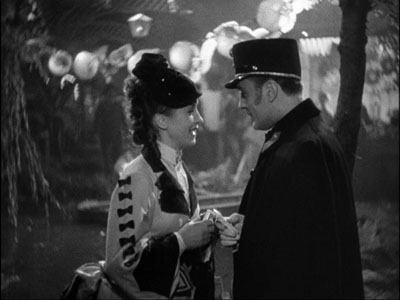
The story follows the outline of many a tragedy. The young Archduke Rudolf first goes astray by entertaining rogue political ideas. He is friends with Szeps (Rene Bergeron), a rabble-rousing newspaper editor known to be part of anti-monarchy protests. Rudolf is quickly put into line and pushed into an arranged, loveless marriage. The years pass, and Rudolf lets most of them go by drinking and partying with his buddies and loose-moraled gypsies. The party boy image is a front, however, and Rudolf yearns for an anonymous life and true love. He finds both when he runs into Maria Vetsera, who at first doesn't realize who this handsome soldier is. When they find each other again, they begin a secret affair, one that eventually becomes public. When the pope turns down Rudolf's request for a marriage annulment so he can be with Maria, the prince reaches the end of the line. Told by his father (Jean Dax), to get rid of Maria, Rudolf resorts to drastic measures. They go on an overnight trip to Mayerling, never to return.
The screenplay for Mayerling was adapted by Joseph Kessel (the novel Belle de jour) and Irma Von Cube (Johnny Belinda) from a novel by Claude Anet. The spicy historical details, and I am sure more than a few embellishments are all there, though I imagine the 1930s production code kept the filmmakers from going too far with what really went on. References to whores and lewd carryings on make it slightly more risqué than had it been a Hollywood production, but the folks in California also knew clever ways of getting more scandalous points across without saying everything outright. There are moments when I thought maybe I was supposed to infer more than what was being shown--like, were Rudolf and Szeps gay lovers, in addition to political radicals?--but also thought that could have been my modern eye spying things that weren't really there.

Litvak stages Mayerling as a grand spectacle, including nights out at the ballet and fancy-dress balls. The evening at the theatre, when Rudolf and Maria see each other for the first time after their chance meeting, is put together wonderfully. Litvak moves up and down and in and out of the various boxes, using a modified upstairs-downstairs technique to indicate the levels of the class structure in the royal court. His camera flies on the wings of gossip, mostly lead by the Archduke's cousin, and the whispered plans for future rendezvous provides Mayerling with its only real heat. Except for their final outing together--and we know how that one ends--most of the lovers' meetings look to be ridiculously chaste. Though, one has to wonder why army officers weren't more careful back in the day when they took their mistresses out for drinks. Rudolf getting caught out by his men, as well as Maria's brother, is remarkably similar to Lord Nelson being discovered boozing with Lady Hamilton in Alexander Korda's That Hamilton Woman.
Though we are apparently to believe that Maria Vetsera is a ripe seventeen, Danielle Darrieux and, indeed, the whole movie comes off as much older than that. Mayerling is really too mature. It needs a touch of Romeo & Juliet adolescent angst to give this star-crossed love affair a little more oomph. Even Rudolf's quickly jettisoned political rebellion could have been cranked higher. For a guy doing his best to piss off his father, he cordially stays out of the old man's face. There is little to signal that these two are passionate or dramatic enough to want to take their own lives. It's a development that comes out of nowhere, and seeing Boyer's shaky determination in the final scenes made me wonder where this kind of emotion had been in the preceding 90 minutes. Even the atmosphere out at Mayerling is different--more desolate and remote, with the lovers playing hide and seek on a late foggy night.

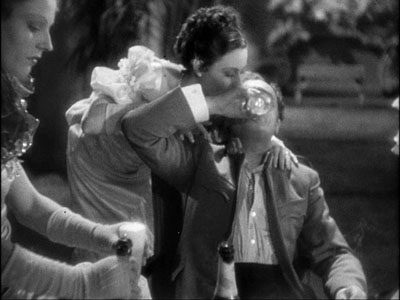
Anatole Litvak would eventually leave France and enjoy a fairly successful career in Hollywood, including directing the jazz film Blues in the Night, the desperate noir The Long Night, and another historical drama, Anastasia
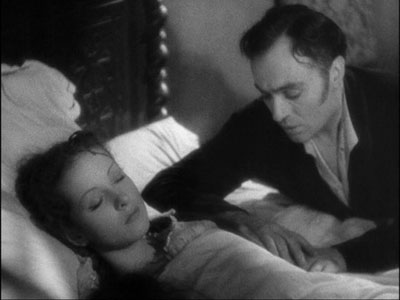
This does make me wonder, though, is there a more definitive version of Mayerling out there? There are multiple films of the story, including one with Omar Sharif and Catherine Deneuve, and even interpretations off the screen--a ballet, a German opera, a Japanese musical, and a manga, of all thngs. What say you readers? What do you recommend?
By the way, in researching this article, I discovered that a 9-minute clip of the Audrey Hepburn/Mel Ferrer production is now online and that we may actually see this surface in the future. Info here, and the clip itself:
Thursday, November 12, 2009
GOMORRAH - #493
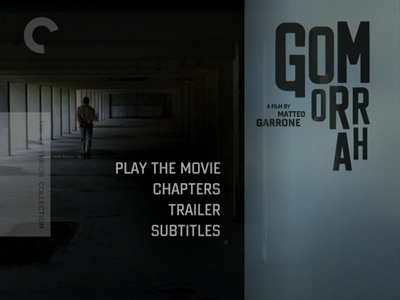
When I first saw Gomorrah earlier this year, I was at a loss for how to easily describe it to people. It's a complicated work, packing into 2 hours and 17 minutes enough story to cover an entire season of a quality cable television program. In the end, I turned to one such program for my analogy. You know the Hamsterdam storyline in the third season of The Wire

Directed by Matteo Garrone and adapted by a squadron of screenwriters (six in total) from the journalism of Roberto Saviano
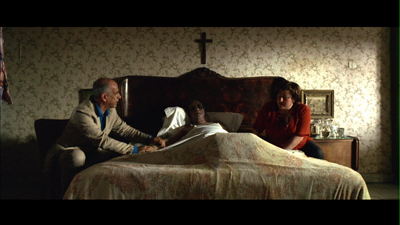
Gomorrah is a multilayered film, moving up and down the criminal lines to look at the different levels of the mafia organization. Garrone presents five separate stories, all running parallel, all sending whatever money being earned in the same direction, but never crossing over. This starts young, with a rookie being indoctrinated into the club, and runs all the way up the flagpole to a veteran swindler who is now working the business end of things. Franco (Toni Servillo, also seen this year in the aesthetically similar political film Il Divo) is running a waste management scheme, though unlike the waste management in The Sopranos, it's a real operation, not a front. He offers to unload any garbage, no matter how toxic, for half the price of his legitimate competitors, finding remote locations where he can hide the stuff away. He even pays farmers who are in debt to let him further sully their land. Franco is a go-getter, and he never uses a gun, he is capitalism personified. His social justification: screw the other guy if it means helping your own. Or, more importantly, yourself.

On the other side of things is Toto (Salvatore Abruzzese), a kid from the slum who goes from delivering groceries to muling drugs in one easy move. The chilling thing here is not that Toto chooses to be a part of the warring gangs, but how easily he does it. There doesn't seem to be much thought to it, it's just the next logical step at his age. His trial by fire is standing still wearing a bulletproof vest and letting one of the enforcers shoot him in the chest. Toto could conceivably survive to one day be like Franco, though he is more likely to be one of the anonymous dealers that run the day-to-day and who either get arrested or shot. In such a case, the Family takes care of the family of their fallen comrade, and actually Toto is best reflected in Don Ciro (Gianfelice Imparato), the delivery man who brings the salaries to those left behind. Dressed in a beige windbreaker, dutifully following his list, Don Ciro is a big nothing in the grand scheme of things, and he knows it. He is a small speck within the larger construct, and as it all continues to engulf him, he's losing his nerve.
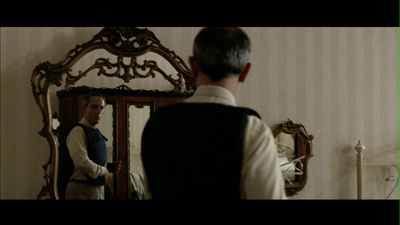
See how complicated this all is? And that's still only three of the five stories. All aspects of life are represented in Gomorrah, the garbage people pump into themselves and the garbage they pump out--literally and metaphorically. Whole industries thrive within Naples, including underground garment manufacturing. Designers come in with a clothing line, and different sweat shops bid on how quickly and cheaply they can make a large order. Top of the line in terms of production is Pasquale (Salvatore Cantalupo), a tailor who knows how to get results. His boss is a bit of a shyster, however, and never comes through on promised bonuses and overtime pay. When a Chinese rival approaches Pasquale to come give his workers a tutorial in how to produce quality on the cheap, Pasquale takes him up on it. It's not the best choice. This is akin to a criminal double-cross and not without its consequences.
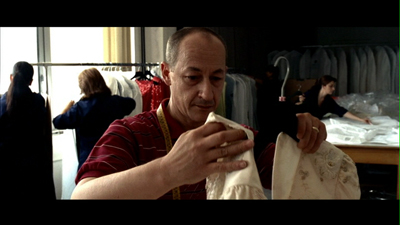
The final story is the most memorable and perhaps the most important. Wreaking havoc throughout Naples are two teenage boys, Sweet Pea (Ciro Petrone) and Marco (Marco Macor), two self-styled Scarfaces who fancy themselves big-shot Mafioso. They steal drugs and guns and thumb their noses at the local crime bosses. They are media culture come to dangerous life, hip-hop wannabes with more bravado than sense. Yet, they are also complex characters, their seeming lack of motivation beyond their own pleasure actually being a smokescreen that masks their frustration at not being able to uncover their own hidden depths. When not in action, they are restless and lost, always looking for something to occupy their feral minds. Sweet Pea in particular seems out of step with himself, shy with women and quick to panic when the violence turns against him. In a scene after their first on-screen drug heist, he dances to music on the jukebox, making come-hither advances on Marco, suggesting a homoerotic tension underlying their relationship. The sequence actually reminded me of Wong Kar-Wai, with the music, the Hawaiian shirts, and the inability to communicate passion.

Garrone apparently borrows Gomorrah's aesthetic from Saviano's book, which blended reporting with fictional technique to make something that was more evocative of the reality by bending the facts to fit the writing style. Garrone's regular director of photography, Marco Onorato, shot Gomorrah like a documentary, and the editing by Marco Spolenti favors long cuts, letting the camera move in and around the action rather than jumping between the actors with more traditional coverage. There is no effort made to gloss this story up with fancy gunplay or clever "street poetry" dialogue. Sometimes having the characters say nothing is more effective, and when they do talk, it's often clumsy, repetitive, and reflective of their station. Though literary themes are built, including plenty of dualities and an image near the end that shows human bodies being treated very much like Franco's barrels of toxic waste, there is no attempt made to sew these things up, no great "ah-ha!" moments. In fact, the only time the film attempts to moralize is the only time it falters. Franco is given a chance to defend himself when his protégé walks out on him, and his "the world needs men like me" speech is surprisingly on the nose for a script that otherwise avoids being so obvious.
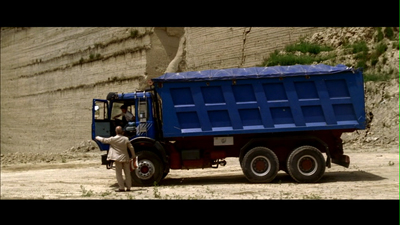
Nearly 1,200 words in, and I still find myself circling what really makes Gomorrah tick. This is the kind of movie you just have to climb in and roll with it. I admit, it's actually easier to comprehend, and thus more rewarding, on a second viewing, because there are so many characters and different elements to keep track of, the first time through, I was just getting acclimated. There were whole segments I forgot about from one watching to another, it was practically a new movie for me anyway.
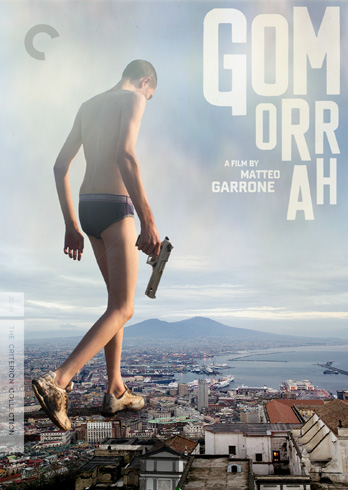
Special kudos go to Neil Kellerhouse for his exceptional and evocative package design for this release. The images he chooses--and partially creates--reflect the depth of the story in both terms of narrative complexity and literal spatial connections. The cover of the interior booklet shows an aerial shot of Don Ciro walking amongst the bodies of the slain, looking past walls and ceilings and creating an illusion of higher and lower, as if he is separated from them even though he is right there in middle.
More striking is the cover of the actual box. The other Ciro, the young thug, is shown in his bathing suit and tennis shoes, brandishing a pistol, and walking over the city like a malevolent god. In thumbnail form, the way I kept seeing it online, it just looks like a still from when he and Marco are having target practice at the river. It's only when you really look at it and see it at regular size that the full picture becomes clear.
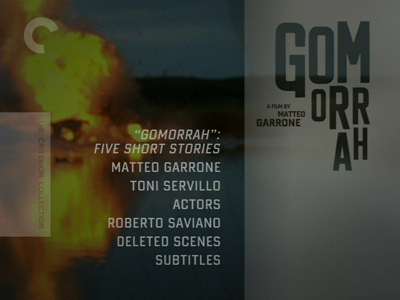
The whole DVD experience for Gomorrah is enhanced to peel back the various layers and show the schematic of the narrative. A second disc is devoted to the behind-the-scenes on the movie, including new interviews with Matteo Garrone and Roberto Saviano, as well as an hour-long look at the making of the film and the five stories that form its whole. Given the way the movie already blends fact and fiction and blurs the lines between, it's all the more fascinating to obliterate the illusion altogether. Moviemaking is its own bizarre version of reality, a kind of separate fiction where real life is surreal anyway, so in a case like Gomorrah peeking behind the curtain locks everything together like fingers on two corresponding hands.
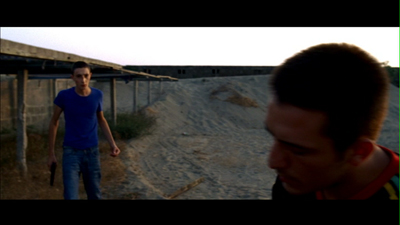
This disc was provided by the Criterion Collection for purposes of review. It will be in stores on November 24.
Friday, November 6, 2009
THE HIT - #469
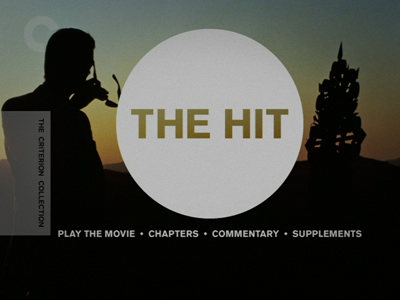
At the end of last night's episode of The Office, Michael Scott (as played by Steve Carrell) says that, in a moment of what was admittedly mild violence, he saw his life pass before his eyes. In the end, he had four kids, a hover car, and a hover house. I guess that's one benefit of being an "optimist savant" (I doubt that's a term, but there it is): what everyone else sees as a finale, you see as a beginning. The rest of us see into the past, your imminent death is not an imminent death, but a window to the future.
I didn't think about that at all while I was watching Stephen Frears' 1984 crime picture The Hit. I rolled from my Thursday night sitcoms into this British pulp without considering if there was a thread between them, because why would I? It was only when I was pondering whether there was some other way to open this review than with a cold summary that it came back to me. If Michael Scott were to be kidnapped by a pair of criminal assassins and taken on a drive out of Scranton to New York to have his brains blown out in front of David Wallace, it would likely never occur to him that he was really going to die. He would smile and chat and roll along in oblivious contentment. His is the certainty of survival.
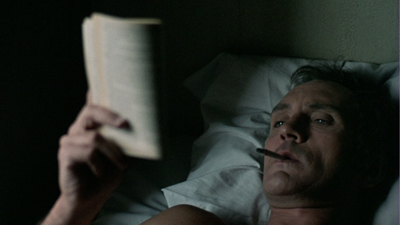
It's quite the opposite for Willie Parker, the aging gangster played by Terence Stamp in The Hit. He knows exactly what is waiting for him: the certainty of death.
The Hit opens in the mid 1970s. Willie has turned state's evidence, selling out his partners in a couple of bank heists in trade for immunity. As he exits the courtroom, the men he doomed serenade him with "We'll Meet Again," the old standard made famous by Vera Lynn during WWII. It's a sentimental tune turned to threat.
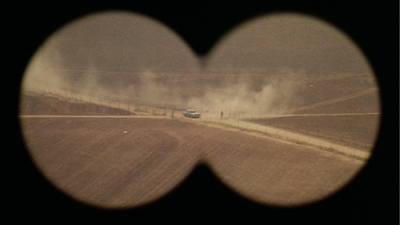
Flash forward ten years and Willie is holed up in Spain, living a life of quiet contemplation, alone with his books, bicycling the countryside. The jig is up for Willie, however, and that day, a group of young thugs are waiting for him. They put a sack over his head, throw him into a car, and deliver him to a pair of killers who have come looking for him. One is an experienced triggerman named Braddock (John Hurt), the other a twitchy kid by the name of Myron (Tim Roth), a bleach-blonde punk on his first job. Braddock and Myron are to drive Willie up to Paris, where he can answer to the recently released crime boss he put in jail. Then he will be shot.
It was meant to be an easy grab-and-go, but the kids who nabbed Willie killed the cop who was guarding him on their way out and so now the heat is on. The police are on their trail pretty quickly, though always a few steps behind. The posse is lead by an officer played by the great Fernando Rey, whose presence is always felt despite the fact he only has a couple of lines to speak at the very end of the movie. That's star power right there, commanding the screen without saying a word.
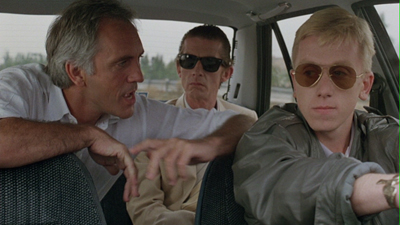
The road trip is one of constant screw-ups. A detour to get a new car off a local hood gains the group a fourth passenger, a Spanish prostitute named Maggie (Laura del Sol). The same stop also adds another body to the pile-up, Maggie's British boyfriend, another ex-patriot crook (Bill Hunter). Each pit stop only serves to blow their cover more, the cool criminals slowly unthawing and unraveling. Myron suspects this is all Willie's doing, that the Zen master with the white hair and white clothes has a plan to get under their skin and unnerve them, and judging by the evidence, he may be right.
Willie's monastic lifestyle seems to have served him well. When we first see Willie in court, he doesn't appear to be very smart. He's slow on the uptake, and it turns out he was merely the driver for the robberies. It's a low-level position in the criminal scheme of things, but symbolically, Willie does fulfill a role as a delivery agent, shuttling the others to their fate. By the time his own fate catches up with him, he is older, wiser, better spoken, and seeming free of any cares. He lightly accepts his kidnapping, cleverly manipulating Myron for information and needling both men in stressful situations to fray their nerves and give them cause to doubt the other. He's got them both made out pretty good, and he particularly sees Myron as a weak link. This is Tim Roth's big-screen debut, and he's already a feral little weasel, particularly as displayed in an impromptu fight Myron engages in at a roadside bar. He doesn't know when to shut up or settle down.
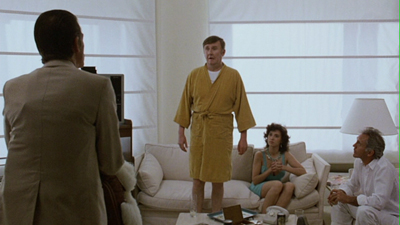
Braddock is the opposite. He is cool and measured, and John Hurt is as cold as Roth is hot. This puts Willie in the middle as someone who is neither one nor the other. His refusal to show concern, to scream or fight or even try to escape, undermines the confidence of both men. He knows he's going to die, what does he have to be so happy about?
Well, everything really. Willie has accepted that all life is transient, that death is a move from one state to the next, and as he tells Myron, what happens on one side is pretty much the same as what happens on the other. If John Lennon, one of his personal heroes, could face the Grim Reaper, so can a nobody like him. Today, tomorrow, what's the difference? There is an almost religious serenity to how he carries himself. He looks like he is dressed to go down to the water and be baptized, a costume that I can only assume is intentional, particularly since on what could be his last evening on Earth, rather than run for it when he gets the chance, Willie instead stands by a waterfall and lets the mist cleanse him.
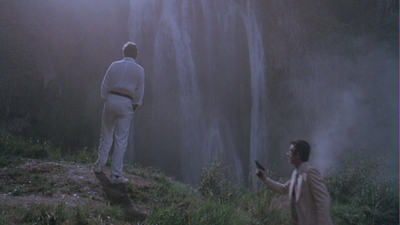
In the midst of this, the girl is the wild card. If being robbers is a game that boys play because they decided to never grow up, then the women are on the other side of the board where the game gets real. Unlike Willie, Maggie wants to survive, and indeed, has been making moves to ensure her survival since before these guys crossed her path. Laura del Sol is smart and feisty in the role, constantly looking for an angle out. Hers is the part of the watcher, the one who must always be looking and then react.
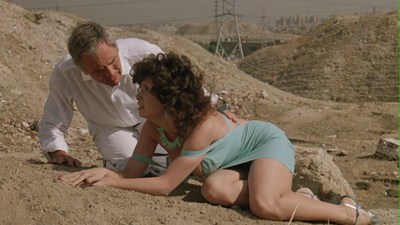
Stephen Frears had an extensive television career before transitioning into features with The Hit. I am sure the no-fluff approach displayed here is attributable to that background. When you're used to constrained resources, you learn to make anything count, and there is certainly nothing wasted here. The look of the film (it was shot by Mike Molloy) is cold and bare, with the action mostly taking place either in the car or in big, open spaces. The script by Peter Prince (Waterland) is extremely economical. There is nothing said in this film that doesn't advance the narrative. No stray outbursts from Myron, no extraneous speeches from Willie. Like I noted, we don't even get any instructions from the head of the police, they maintain a silent pursuit. Confidence affords an artist the luxury of never having to explain himself.
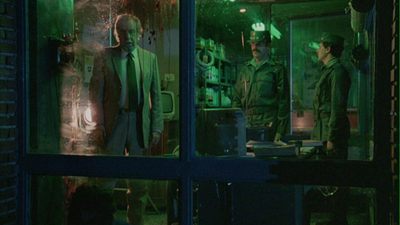
Like any road movie, The Hit isn't really about where these people are going, but how they get there. Or more accurately, how they arrive. Prince and Frears save a few surprises for the finale. When faced with the inevitable conclusion, each person reveals his or her true nature, and ultimately, the movie says something about what it means to live tough. (Spoiler: the toughest of all is the one without the penis.) Who is posturing, who has the courage of their convictions, will any of them see their future staring back at them from the barrel of a gun--these are things you have to watch the movie to find out.
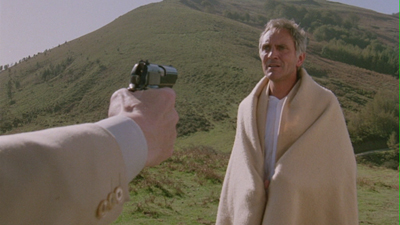
Subscribe to:
Posts (Atom)
